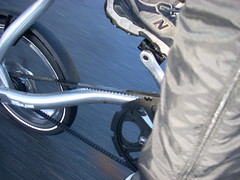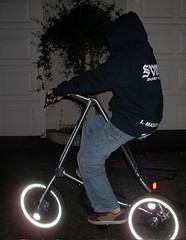I tried a Strida 3.2 folding bike on the show floor at Interbike 2007 last September and looked at the early pre-production 5.0 models. I liked it enough that I put a Strida on my Christmas wish list. Santa Claus arrived a little early to my household in the form of the FedEx man dropping off a big brown box labeled “Strida” and “DESIGNED IN THE UK” in big bold letters. My Strida 5.0 folding bicycle had arrived!
The distinctive features of the Strida 5.0 include its triangular frame, light weight (19.4 pounds), a clean belt drive, incredibly fast folding, and compact size both folded and unfolded.
Assembly required
Areaware in New York is the U.S. importer and distributor of this UK designed folding bicycle. While they’re working on developing their US dealer network, most purchases right now will be through online purchases over the Internet. That means you’ll receive your bike in a box just like I did and some assembly is required.

The Strida bicycle comes “folded” and partially unassembled in the box. While folding and unfolding the Strida is amazingly fast and easy, the first time was a little tricky. I’d say it’s helpful to read the instructions first, but to be honest, the instructions are non-intuitive illustrations. It might be handy for some people to find a YouTube video and watch that in addition to looking at the instruction book. Beware when folding the bike for the first time — the first time I tried folding this Strida, I did it completely wrong and popped the top part of the triangle out of its ball joint. It took some spirited whacks with a mallet to get the pieces back together. (Don’t worry, Areaware — I put padding on the tube to protect the finish!)
The bike comes with almost everything attached and adjusted. Handlebars, brakes, pedals, tires and wheels and belt are already put together. It’s up to the end user to install the saddle and rear rack. On a conventional bike, saddle adjustment is trivial: you just loosen the seatpost binder and slide the saddle up and down. The saddle attachment on the Strida folding bike is somewhat less trivial and involves four bolts and quite a bit of wiggling, so you want to get it right the first time. It might be helpful to set another bike next to the Strida so you can compare saddle heights.
After installing the saddle, you install the plastic rear rack. With a 5 kg / 11 lb weight limit the rack’s utility is limited, but it’s a handy place to hang a rear light and stash a lock and rain jacket.
Design engineering
The engineering and quality on the 5.0 is a big step up from the 3.2. Besides the minor issue of saddle installation and adjustment (a one time ordeal), I was frankly very impressed with how smoothly everything just goes together on this bike. The brushed TIG welded aluminum frame looks very sharp and sleek. All of the mechanical engineers at my office are oohing and aahing over this bike right now (one of the guys literally sniffed the frame!) and absolutely love the design. These same designers won the Industrial Design Excellence Award in 2006. Another design engineer, James, gives his impressions of the Strida design on his Bicycle Design blog.
Other features of the 5.0 include Kenda Kwest 16″ tires with reflective sidewalls on 24 spoke aluminum wheels, disc brakes, folding handlebars and folding pedals. Strida is manufactured in Taiwan by a contract bike manufacturer. Strida folding bikes are reportedly the best selling folding bike in Taiwan.
More to come
I’ll put the Strida 5.0 folding bicycle through its paces over the next month and let you know how it goes in this Strida category. You can also view my photos of this bike on Flickr. So far, I’m impressed with the looks, the engineering and apparent practicality of this folder.
More information about the Strida 5.0 and other models is available at Strida’s website.

